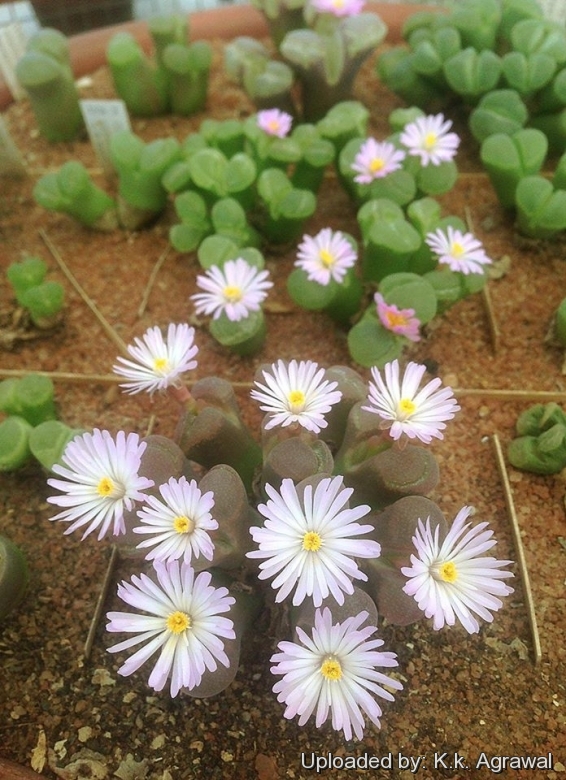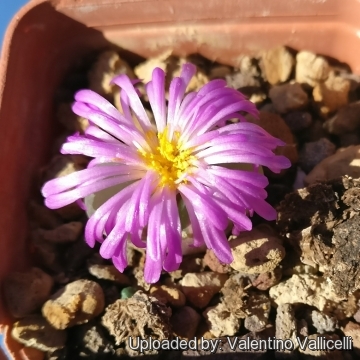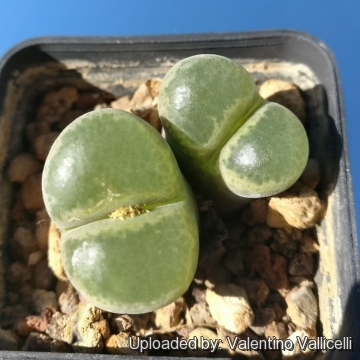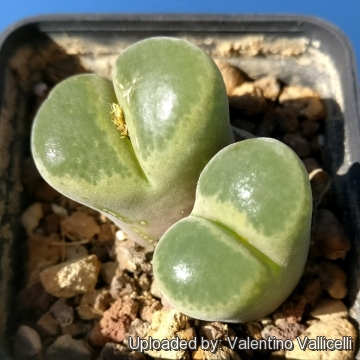
Conophytum praesectum Photo by: K.k. Agrawal
The bodies are light brownish to ochre, or light clay colour (rarely greenish), and flower lilac pink or rich purple flowers, others are pale pink or pure white.
Origin and Habitat: South Africa (Pofadder area, Cape Province).
Altitude range: 1000 - 1150 metres above sea level.
Habitat and ecology: Conophytum praesectumSN|28071]]SN|28071]] tolerates highly arid situations and the small heads tend to be buried in quartz grit and be almost invisible if not in flower. It lives in a winter rainfall region.
Synonyms:
Description: Conophytum praesectumSN|26961]]SN|28071]], used to be in the genus Opthalmophylum which is now obsolete, is a member of the confusing Conophytum longumSN|28071]]SN|26961]] complex. It is a dwarf perennial succulent plant usually with only one softfleshed, stemless body telescoped to a single pair of compressed, united leaves, but may form small clumps, especially in cultivation. The name praesectum is usually applied to plants in the Pofadder area that have a lot of red-brown colouration in the leaves. Some populations produce dainty pink or rich purple flowers, others are pale pink or pure white, and some are mixed.
Bodies (paired leaves): Somewhat taller growing, 17-30 mm high, 8-18 mm wide, 4-12 mm thick, compressed, cylindric or oblong when viewed from the side, apex obscurely windowed, slightly translucent, the rest dotted, olive green, ochre, light clay colour to chocolate above (rarely greenish).
Flowers: Up to 3 cm in diameter. Petals pink to violet. The big purple flowers cover all bodies and nothing is visible.
Bibliography: Major references and further lectures
1) Heidrun E.K. Hartmann “Illustrated Handbook of Succulent Plants: Aizoaceae A-E” Springer, 2002
2) Gideon Smith u.a. “Mesembs of the World: Illustrated Guide to a Remarkable Succulent Group.” Briza Publications, 1998
3) Japan Succulent Society “Colour Encyclopedia of Succulents” Japan Succulent Society January 1, 1981
4) Hermann Jacobsen “A handbook of succulent plants: descriptions, synonyms, and cultural details for succulents other than Cactaceae, Volume 1” Blandford Press, 1960
5) Werner Rauh “The Wonderful World of Succulents:Cultivation and Description of Selected Succulent Plants Other Than Cacti” Smithsonian Institution Press, 1984
6) James Cullen, Sabina G. Knees, H. Suzanne Cubey “The European Garden Flora Flowering Plants: A Manual for the Identification of Plants Cultivated in Europe, Both Out-of-Doors and Under Glass” Cambridge University Press, 11/ago/2011
7) Steven A. Hammer “Dumpling and his wife: new views of the genus Conophytum” EAE Creative Colour Ltd., 2002
8) Victor, J.E. 2006. Conophytum praesectum N.E.Br. National Assessment: "Red List of South African Plants" version 2014.1. Accessed on 2014/07/16
 Ophthalmophyllum praesectum ARM320 North of Pofadder. Photo by: Valentino Vallicelli
Ophthalmophyllum praesectum ARM320 North of Pofadder. Photo by: Valentino Vallicelli Ophthalmophyllum praesectum Gabaib, South of Achab (greenish bodied form) Photo by: Valentino Vallicelli
Ophthalmophyllum praesectum Gabaib, South of Achab (greenish bodied form) Photo by: Valentino Vallicelli Ophthalmophyllum praesectum Gabaib, South of Achab (greenish bodied form) Photo by: Valentino Vallicelli
Ophthalmophyllum praesectum Gabaib, South of Achab (greenish bodied form) Photo by: Valentino VallicelliSend a photo of this plant.The gallery now contains thousands of pictures, however it is possible to do even more. We are, of course, seeking photos of species not yet shown in the gallery but not only that, we are also looking for better pictures than those already present.
Read More... Cultivation and Propagation: The Conophytums belonging to the Ophthalmophyllum group are some of the world's most fascinating plants and are sought by the collector of succulent plants. They grow on winter rain and heads for summer dormancy. They are notoriously difficult to grow because they rot very easily. Paying attention to the particular growing requirement of Ophthalmophyllum is especially important. If you provide the Ophthalmophyllum with the right conditions, they will reward you with their unique shape, size, colour and a proliferation of blooms in autumn. However, Ophthalmophyllum are tricky plants that are very particular about their growing conditions and require the right maintenance in order to keep happy. But don't be afraid even the best growers have plants that mysteriously dry up, or leave during the night. While Ophthalmophyllum are picky about their care, if you are patient and remember the basics, your efforts will be rewarded. Being small plants, a representative collection can be grown on a patio table, a sunny windowsill or a shelf in the greenhouse.
The growing season in northern hemisphere is from September to March.
Soil: It grows best in sandy-gritty soil and requires good drainage as it it is prone to root rot. It can grows outdoor in sunny, dry, rock crevices (protection against winter wet is required) It can also be cultivated in alpine house, in poor, drained soil.
Repotting: Repotting every year is not recommended. They may stay in the same pot for many years. Plants grown in larger containers have frequently relatively poor flowers. They might improve when the plants are given their own, small individual pots.
Fertilization: Feed it once during the growing season with a fertilizer specifically formulated for cactus and succulents (poor in nitrogen), including all micro nutrients and trace elements diluted to ½ the strength recommended on the label. It thrives in poor soils and need a limited supplies of fertilizer to avoid the plants developing excess vegetation, which is easily attacked by fungal diseases.
Watering: The Ophthalmophyllum thrive in dry and desert regions and are able to stand extended periods of drought and require careful watering. Water minimally in summer, (only occasional misting), water more abundantly after the previous year's leaves have dried up when they are growing in the autumn and spring, but let the soil dry between soaking. Requires little water otherwise its epidermis breaks (resulting in unsightly scars). If grown in a container, bottom watering by immersing the container is recommended. Ensure a very good ventilation.
Light: It enjoy some shade (avoid direct sun as it grows wild among rocks and under the shade of other plants) and in summer it need to be kept in a cool area.
Hardiness: It prefer a very bright situation and require a minimum temperature 5°C (But will take a light frost and is hardy down to -7° C for short periods if it is in dry soil). USDA zones 9A – 11.
Uses: Container, rock garden.
Pests and diseases: It is vulnerable to mealybugs and rarely scale.
Propagation: It can be reproduced both by seed in autumn or (or rarely) cuttings. Take the cutting from a grown-up mother plant. Each cutting must contain one or more heads along with a fraction of root and permit to dry out a couple of days, lay it on the soil and insert the stem end partially into the soil. Try to keep the cutting somewhat upright so that the roots are able to grow downward. It is relatively difficult to root Ophthalmophyllum from cuttings and generally pointless as well, so quick are they from seed.













